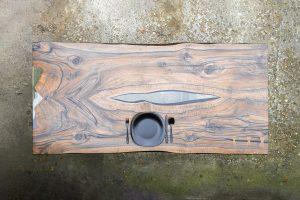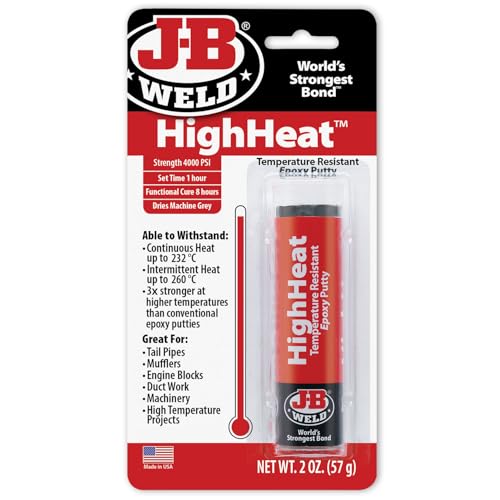In recent times, the use of various types of epoxies for a wide range of applications has skyrocketed.
![Heat Resistant Epoxy 101 [A Guide for High Temperatures] Interior design of stylish dining room interior with family wooden and epoxy table, rattan chairs, flowers in vase and teapot with cups. Details. Template.](https://homesthetics.net/wp-content/uploads/2022/01/Heat-resistant-epoxy-2.jpg)
Epoxy has become a panacea for all creative quests, from repair to home decor and even art. Since there is such a wide range of uses for epoxy, manufacturers have also started offering different types of epoxy products for other projects. There are all-purpose epoxies, weatherproof epoxy products, heat-resistant epoxy resins, and many more.
Selecting the correct type of epoxy is not easy, especially for those who are first-time users. This fact is especially true if you are looking for heat-resistant epoxy for your project. There are several factors to be considered. This article will help you learn how to find the right type of heat-resistant epoxy, helping save both your time and effort.
Let us get down to it then!
All About Heat Resistant Epoxy

Is Epoxy Resistant To Heat?
Epoxies are a class of chemicals that includes adhesives, plastics, and other similar materials. Since it is a vast class of compounds, different epoxies come into use in almost every industry.
One of the most common uses of epoxies is as an adhesive, usually in structural and engineering applications.
The most common epoxy resin available on the markets is usually used for DIY projects, such as repair work, art pieces, jewelry making, etc. This standard epoxy is resistant to heat up to a specific temperature and distorts if the temperature rises further.
High-temperature epoxy resins are a different type of product that is specially manufactured to withstand extreme heat. Such epoxies are usually required for applications where high physical strength is needed, as these compounds can withstand high stress without getting distorted.
You can easily find heat-resistant epoxy resins on the market, suitable for DIY projects such as making coasters. These resins can endure a reasonable amount of heat but are not ideal for extremely high temperatures.
How Much Heat Can Epoxy Resin Endure?
The standard epoxy resin available for home projects can withstand temperatures ranging from 150°F to 300°F for a short duration. On the other hand, heat-resistant epoxy can endure extremely high temperatures of up to 600°F. The resistance varies slightly depending on the product and the manufacturer.

What Is A High-Temperature Epoxy Resin?
Heat Resistant Epoxy Resin is a particular type of compound specially manufactured for industrial applications, such as automobiles, aircraft, etc. It is also used for larger projects like coating kitchen countertops to protect them from heat.
Industrial applications include mechanical and electrical repairs, generally in aircraft and automotive industries. Other industries where this epoxy resin is highly usable include communications, marine sectors, industrial control equipment, etc.
High-temperature epoxy resin is also used in structures and composites. In such applications, a bonding agent, sealer, or coating agent is generally used. Therefore, the epoxy needs to be highly durable and long-lasting for such purposes.
Using this epoxy along with a high-temperature surface coat helps create tough, durable, and high-resistant equipment.
Temperature Limits For Epoxy Resin
The standard basic epoxy generally used for DIY projects can withstand low heat temperatures ranging from 68°F to 195°F. If it is subjected to temperatures higher than this, its molecular structure will start to change.
It can assume a rubbery surface instead of its solid glass-like texture. This leads to softening of the epoxy and distortion in its shape. That is why it is highly recommended to use a potholder or coaster on epoxy surfaces to keep articles such as hot beverages.
The situation is entirely different in high-temperature epoxy resin, as it is specially manufactured to withstand temperatures up to 600°F. As mentioned above, this range depends upon the individual product as well as the manufacturer.
Companies generally manufacture high-temperature epoxies with added fillers such as quartz. It is also common to reinforce such epoxy resins with elements like titanium, enabling them to endure extremely high temperatures.
Benefits Of Using A High-Temperature Epoxy Resin
There are several advantages that a high-temperature epoxy resin offers. It enables applications that are not suitable for regular epoxy. Some of these advantages include:
- It is the perfect product for creating incredible designs and finishes for tabletops and countertops.
- The epoxy resin is ideal for use on various surfaces in the kitchen, bathroom, table, etc., renovation or restoration.
- Stone Coat Epoxy resin is one of the most durable resins and provides excellent durability and strength.
- It is also flame retardant, helping prevent fires and slowing down their spread.
- One of the best things about this product is that it offers a highly polished finish and an even and flat surface.
- The manufacturer has altered the epoxy formula to make it resistant to UV rays as well, making it suitable for surfaces exposed to sunlight.
- Finally, the product is food-safe, allowing you to use it conveniently in the kitchen.
- There are also high-temperature epoxy resins available that are vegan and cruelty-free.
- High-temperature resin epoxies work well with silicone molds and are an excellent option for artwork.
- The clear-drying property makes such resins suitable for a wide variety of applications.
- Such resins are also highly resistant to chemicals like sulfuric acid, marine environments, humidity, and corrosion.
Disadvantages Of High-Temperature Epoxy
High-temperature epoxy makes it possible to complete extremely high-temperature projects at home. However, there are a few things regarding the product that you should take into account:
- The high-temperature epoxy may acquire a yellow tint after curing, making it unsuitable for projects that require a transparent appearance.
- In some instances, additional heating methods may be required during the curing process, increasing the overall time to complete the project.
- High-temperature epoxy resins are generally more expensive than basic epoxy.
- Prolonged use of epoxy can also lead to skin infections and allergies such as dermatitis.
- Even a slight deviation from the provided instructions affects the heat resistance capacity of the resin.
Preventing Reduction In Temperature Resistance
There are several methods to reduce the temperature resistance of the epoxy resin. The first thing is to ensure that the mixing ratio is correct, as any change in that can alter the nature of the resin.
Similarly, it is essential to adhere to the manufacturer's instructions, such as the time required for mixing the resin and hardener.
Adding additives such as pigments, colors, or ink automatically reduces the resin's temperature resistance. To prevent this from happening, apply a clear topcoat that will improve the epoxy's heat resistance properties.
Some Useful Tips For Working With Heat Resistant Epoxy Resin
For getting the best results, it is always advisable to follow the manufacturer's instructions as provided with the product. Deviating from the instructions will result in an undesired outcome. Here are some valuable tips to help you through the process:
- It is crucial to mix only the amount of resin required for the project to allow enough time for proper application.
- Proper preparation is necessary before starting the project, as time is critical during the process.
- Using a worktable of the correct height will help avoid back pain while and after working.
- Wipe the workspace clean using Isopropyl Alcohol to remove dust particles before starting.
- Both the temperature and humidity can have unwanted effects on the final product.
- Cold temperatures can cause the product to acquire a sticky or waxy appearance.
- Warming the resin before mixing with the hardener can prevent the epoxy from getting a tacky texture in colder temperatures.
- While working on a large flat surface, use a trowel or leveling tool to spread the resin evenly.
- If using a paintbrush during the process, ensure that it is of good quality to prevent shedding any bristles.
- Another option is to use a brush with dark bristles, which will be easier to spot and remove from the mixture.
- If the mixture has bubbles, remove them using a toothpick or blowtorch. Hold the blowtorch about 20 cm away to prevent dimpling.
- While using a blowtorch, ensure that you start it at some distance away from the project to prevent dust particles from blowing onto it.
- If there are any alcohol inks added for coloring the resin, avoid using a blowtorch to remove the bubbles.
- Use a blow dryer at the highest heat setting to remove bubbles from colored resins, though this process requires more time to complete.
- After completing the project, please leave it to cure in a dust-free place.
- Remember that adding pigments or powders to the resin will change the chemical structure of the resin, reducing its toxicity and heat resistance.
- Make sure to add a clear topcoat to enhance the heat resistance of the project.
- For cleaning up wet epoxy that is leftover, use acetone with a clean cloth.
- In case the epoxy has dried up, use a blowtorch to heat it and a flat trowel or screwdriver to scrape it off.
Best High-Temperature Epoxy To Purchase
The choice of high-temperature epoxy depends on the surface to be coated, and it needs to be able to withstand heavy use and extremely high temperatures. Stone Coat is one of the most popular brands offering an excellent high-temperature epoxy resin.
About Stone Coat Epoxy
The basic epoxy resin commonly used for DIY projects is not suitable for highly high-temperature applications. Stone Coat Epoxy makes it possible to complete such tasks efficiently.
Working With Stone Coat Epoxy Resin
Stone Coat Epoxy Resin is an excellent product for Do It Yourself home projects. To learn how to use it properly, look for step-by-step instructions and video tutorials that will help you through the entire process.
Besides DIY enthusiasts and hobbyists, this product is also convenient for contractors and designers. With this superb product, it is possible to completely renovate old tabletops and countertops, making them more durable and functional.
One point to keep in mind is that the maximum pour depth for each coat is ⅛ inch (3 mm).
Advantages of Stone Coat Epoxy Resin
Stone Coat Epoxy Resin is one of the best high-temperature epoxy resins on the market. Using it offers several benefits, such as:
- It helps save money on the renovation of old tabletops and countertops when you take the DIY route.
- The entire process of using the product is easily explained through an easy-to-understand training video.
- The epoxy resin is entirely environment-safe
- It does not contain any VOCs (Volatile Organic Compounds)
- Using this product will provide you with a completely scratch-resistant surface, highly durable and easy to clean.
- Surfaces where this product is used, such as tabletops and countertops, can withstand temperatures as high as 500°F.
- You also get a non-porous surface that is completely clear.

Steps To Follow While Using Stone Coat Epoxy Resin
Here we lay down some steps that are required to be followed while using Stone Coat Epoxy Resin.
- Accurately measure the hardener and resin in a 1:1 ratio.
- First, mix the compounds thoroughly for the required amount of time, then add colors and additives, followed by the mixing process again.
- Use a flat leveling tool and a blowtorch to remove any bubbles after applying the color coat.
- Wait for 24 hours after applying the color coat before applying the clear coat.
- Use sandpaper to sand down the surface and a wet cloth to wipe away the dust.
- It takes around seven days for the project to get completely cured.
- Once the surface is ready for use, ensure that you keep it clean and avoid scrubbing.

Final Words
While the basic epoxy resin is good enough for most DIY projects, heat-resistant epoxy is the only solution for extremely high-temperature applications. Generally, these are only used for industrial applications, but some manufacturers such as Stone Coat Epoxy Resin also make them available for home projects.
There are several advantages of using high-temperature epoxy resins, and you get fantastic results if the instructions are correctly followed. High-temperature epoxy resin can help remodel, renovate, and restore old surfaces to give them new life. We recommend using it for all high-temperature DIY projects.
We are signing off now. Be sure to leave a comment below!
Related Articles
5 Best Epoxy Resin for Tumblers
9 Best Exterior Wood Stains Today
11 Best Epoxy Resin For Crafts
Waterproof Epoxy 101 [Is Epoxy Waterproof?]
What is Resin and How It’s Used
10 Best Epoxy for Plastic Today
How to Color Clear Epoxy Resin [Coloring Resin
How To Fix Radiator Leak With Epoxy+ Best Radiator Repair Epoxy
Epoxy Garage Floor 101 [All You Need to Know]
Mold Release Guide + Best Epoxy Release Agents
Surfaces Resin Won’t Stick to [All You Need to Know]
Epoxy Cement Guide 101 [How to Repair Concrete with Epoxy]
How To Mix Epoxy 101 [Measuring & Mixing Epoxy Resin Guide]
How To Harden Sticky Resin [Uncured Epoxy Solutions]

